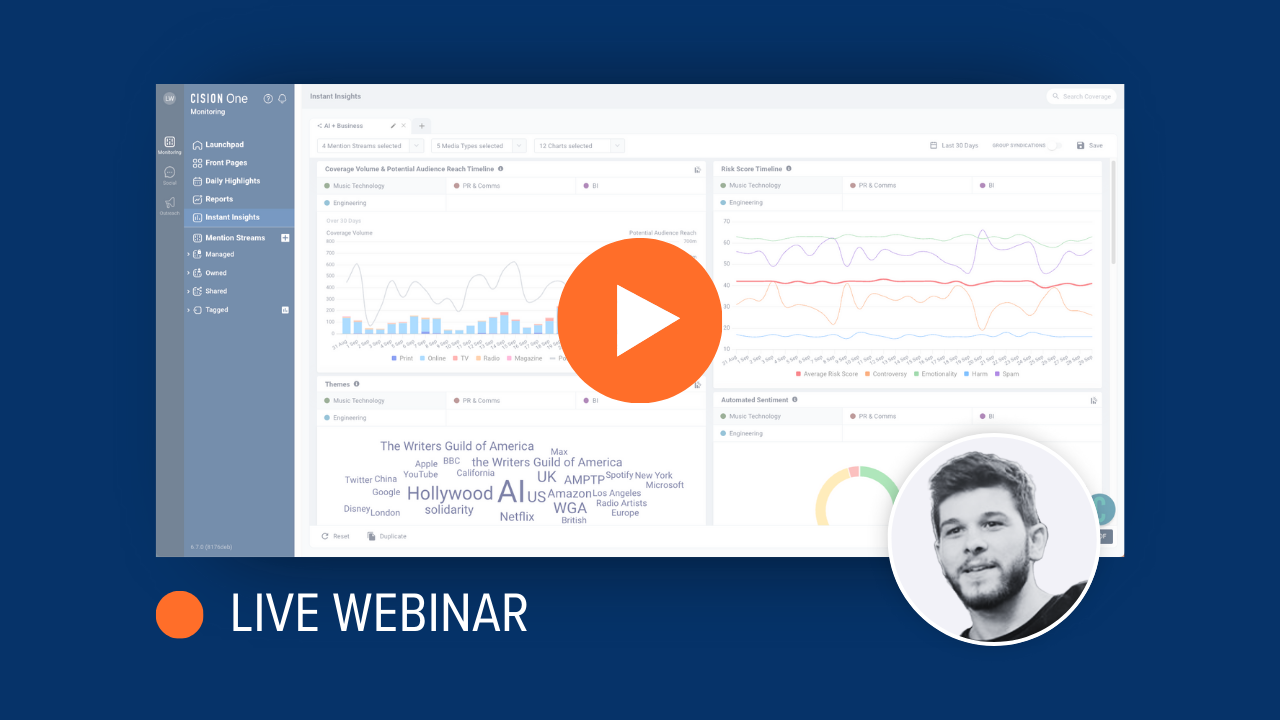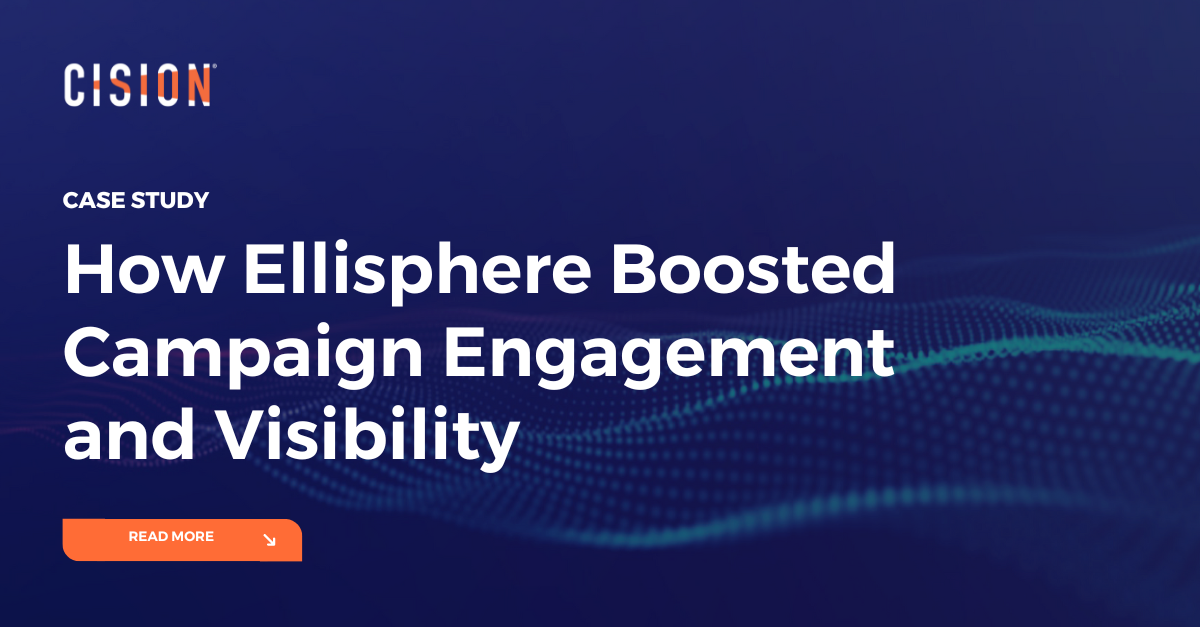Perhaps now more than ever, audience sentiment plays a crucial role in the success of any business, and PR professionals are often responsible for tracking that metric.
According to the 2025 Comms Report, 29% of PR leaders are prioritizing reputation monitoring this year. Yet, increasingly, PR teams are under pressure to go beyond monitoring brand reputation and actually help shape it. According to the same report, 15% expect reputation management to be a priority for their C-suite and senior management.
At the heart of both initiatives is brand sentiment, which is a reflection of how customers feel about a brand, and can help inform where PR teams need to focus their efforts. With the right data and a strategic approach, PR teams can meet the challenge of influencing and improving brand sentiment.
What Is Brand Sentiment?
Brand sentiment, also known as audience sentiment, indicates how people feel about a business and their offering. Brand sentiment typically falls into three categories: Positive, negative, or neutral – each can provide insight into how PR teams should focus their efforts and shape their strategies.
Positive brand sentiment indicates audiences have favorable feelings about a brand or their experience with it – perhaps due to the quality of products or services, how they found the customer journey, or shared values. PR teams can amplify this sentiment by highlighting positive feedback in earned media outreach, press releases, client testimonials, or case studies. These actions reinforce consumer trust by showing real opinions of your brand in an authentic way.
Negative sentiment, on the other hand, indicates dissatisfaction with a brand or a disconnect between audience expectations and experience. Seeing negative brand sentiment presents an opportunity to delve deeper into what's causing it, address problems and show your audience you take their concerns seriously while taking steps to improve.
Neutral sentiment is in the middle, showing that, while audiences are mentioning your brand, they are doing so without expressing strong feelings either way. A high level of neutral emotion can indicate a need to drive more engagement and an opportunity to shape the perceptions of your brand in favorable way.
How To Measure Sentiment
Measuring audience sentiment helps you understand how audiences feel your brand. Without understanding how people feel, your actions may not have the desired impact or bring the change in feeling you’re looking for.
Brand mentions are typically categorized as positive, negative, or neutral. The classification is determined by the wording used, such as identifying positive words and descriptions used about the brand or products to identify positive sentiment.
You can measure audience sentiment by reviewing the language used in:
- Social media posts
- Reviews
- Survey responses
- Comments and responses on media coverage
- Inbound customer communications, such as messages to customer support or help agents
There are a variety of tactics available to help PR teams measure brand sentiment – from do-it-yourself methods to employing tools that automate the process of sentiment analysis. Some of the most common and effective tactics available to measure sentiment include:
- Media monitoring and social listening tools allow you to track mentions of brands and products across print, online, broadcast, and social platforms, assigning sentiment. Tools like CisionOne collate media monitoring and social listening data into reports with actionable insights to help you make informed decisions
- Review websites – Platforms such as Trustpilot, G2, and Yelp are invaluable resources for raw and authentic views directly from your audience. Common features include star or score reviews as well as written reviews, which provide greater detail on the brand, product, or service in question
- Customer Surveys – Gathering thoughts and feelings directly from your audience is an effective way to learn what matters to the people you have already connected with. Regular surveys can show patterns and trends to address, as well as changes in their feelings.
It’s important to note that, when analyzing mentions, relying on individual words to determine sentiment can be misleading. The word “great,” for example, can imply positive sentiment when used to describe a product. However, “great” could also enhance a negative view, such as “great disappointment,” or it could be meant as sarcasm. You’ll need to consider the content in full to determine whether it is positive or negative.
Given how intensive sentiment analysis can be, it’s worth considering investing in tools that automate the process of determining tone and context for more accurate insights.
How Can PR Generate Positive Brand Sentiment?
Knowing the current sentiment around your brand is the first step in generating positive brand sentiment for your organization. Once you know what audiences are saying – and how they feel - about your brand, you can take action to reinforce positive perceptions, address concerns, and turn negativity into positive experiences that people will share and talk about.
PR professionals can improve brand sentiment through the following methods:
Tell Stories Audiences Care About
You can create positive brand sentiment by aligning your messaging with your audience’s needs and values. Ask yourself questions such as:
- What does our audience want?
- Do our offerings meet those wants?
- What challenges does our audience face?
- How can we help solve those challenges?
- What is the best way to connect with our audience?
Effective public relations builds credibility and authority among audiences with compelling, engaging content that audiences relate to or value. Use an expert, for example, to show how your products address problems people talk about. Rather than trying to dictate what your audience wants, learn what they care about and angle your content around those topics, balancing their needs with how your brand can help.
By taking time to understand your audience, you can tell stories they care about while reinforcing your brand’s value.
Share Good News Through Media Coverage
While your website and social media channels are useful tools for reaching new audiences and shaping brand sentiment, media coverage can be even more powerful. But securing media coverage requires more than simply sending out a media release, it requires building relationships with journalists who cover your industry or audience and providing timely, relevant, and newsworthy stories they are likely to pass on to their audiences.
This third-party endorsement not only helps grow brand awareness, but it can improve brand sentiment by enabling you to frame your brand in a positive light
and capture audience attention before they begin their customer journey with you.
Demonstrate Brand Impact
Many brands have missions or values that show not only how they operate, but how they match the values of their audience or local community.
PR teams can bring these values to life by showing how your brand acts on them – perhaps by supporting the local community, the environment, or a charitable cause.
You can use PR-driven content to tell a story about what your brand is doing and what the impact of its actions are. For example, if your company hosted a fundraiser, consider sending a press release or pitching the story to a relevant local news outlet, sharing how many volunteers participated, how much money was raised, and other tangible outcomes. Written content, images, and videos are also great ways to show engagement with community events. You can then repurpose the content across your website, social media platforms, and newsletters. These efforts help demonstrate real impact while generating audience good will toward the brand.
Identify and Empower Brand Advocates
Influencer marketing is a popular way to reach new audiences, but when it comes to improving brand sentiment, employees may be even more effective.
According to the 2025 Comms Report, 52% PR and comms professionals see employees as the most effective influencer on impacting customer behavior – more than any other type of influencer, including celebrities.
Turning employees into brand advocates can enhance or change brand perceptions in a positive way. Employees’ insider knowledge and experience add authenticity and credibility to their messaging about your brand, and audiences are more likely to trust their opinions. When those opinions are positive, it is more likely to resonate with their followers and elevate brand sentiment as a result.
PR teams should look for the right employees – those who are strong communicators and are aligned with company values – and equip them with consistent, on-brand messaging and content support.
Address Customer Problems
People will often let a brand know when they’re not happy. It could be through customer service channels or more publicly on review websites or social media platforms.
There are two ways to deal with unhappy people: you can ignore them, which may only amplify their unhappiness, or you can try to diffuse the situation by engaging them.
Engaging gives you the opportunity to show your audience you genuinely care about their concerns, want to help, and offer solutions. Ultimately, it can help you change a negative experience into something positive.
As the managers of a brand’s reputation, PR pros are often responsible for responding to – or shaping the responses to – both positive and negative reviews. Transparency and understanding are crucial tactics in ensuring both the brand and reviewer are happy by the end of the interaction. These tactics help rebuild trust with audiences, offering proof that the brand cares about its customers and wants to help them, which can further generate positive brand sentiment.
Manage Crises Effectively
Nothing takes a toll on brand sentiment quite like a PR crisis. Whether stemming from a product recall, executive misconduct, or some other reputational threat, a poorly handled PR crisis can erode trust and lead to insurmountable reputational damage. On the other hand, effective crisis management can actually preserve, rebuild, or in some cases, even improve brand sentiment over time.
Spotting a crisis early is important, but so is your response to it. How you deal with a crisis is an opportunity to show your audience you care about rectifying the situation and limit the damage to your brand reputation.
PR teams play a vital role in shaping the right response to a crisis, in an appropriate tone that acknowledges the severity of the situation, validates your audience’s feelings about it, and outlines steps to address it. Equally important is what happens after the crisis has been contained. You should follow through on the steps you take to cement to your audience they matter to you by consistently delivering on promises, making meaningful changes, and communicating with transparency. Such actions help rebuild trust and confidence in the brand, which are key to positive brand sentiment.
Embrace the Opportunity to Improve Brand Sentiment
Creating positive brand sentiment isn’t the sole responsibility of PR, but they are among the most powerful and influential drivers of it. With the right tools and tactics in place, PR teams have the power to shape audience sentiment for the better.
Find out how CisionOne can empower you with the intel needed to improve brand sentiment by booking a demo with one of our experts.
Most Recent Posts
Cision Resources
-
E-books and Guides
Comprehensive how-to guides on strategy and tactics
-
Case Studies
What are other brands doing – and how can we learn from them?
About Dave McCreery
Dave is the Senior Content Manager at Cision specializing in SEO-driven content strategies. He has over 10 years of content creation experience and proven success crafting stories that engage, educate, and entertain audiences across different markets and industries.
Learn More. Do More. demo new
PR Tips, Case Studies, and Product Updates

[On-Demand Webinar] The Next Generation of Media Intelligence: From Gorkana to CisionOne
Explore CisionOne, a revolutionary media intelligence platform, and the evolution of Gorkana. Learn key features and strategies from Luke Williams, CisionOne Product Marketing Manager. Elevate your media outreach to new heights!


